- John Kealy
- Albums and Singles
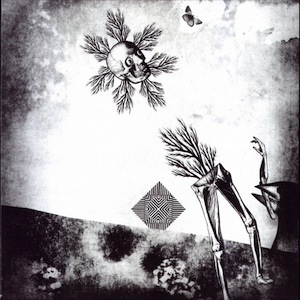 Formerly of Volcano the Bear, Nick Mott has been working on his own music for the last couple of years. This single is a mixed result, too short to give a good idea of where he is going yet it contains glimmers of potential. It looks fantastic with Mott’s distinctive collage-work on the cover but somewhat falls down on the actual music. Luckily the limited edition version succeeds where the regular version fails by adding a substantial amount of music to the work.
Formerly of Volcano the Bear, Nick Mott has been working on his own music for the last couple of years. This single is a mixed result, too short to give a good idea of where he is going yet it contains glimmers of potential. It looks fantastic with Mott’s distinctive collage-work on the cover but somewhat falls down on the actual music. Luckily the limited edition version succeeds where the regular version fails by adding a substantial amount of music to the work.
 
The main part of Almost Entirely of Nerves and Blood is a single sided 7" featuring the title track. Beginning with abstract rubbing of ridged surfaces over a glassy drone, the piece suddenly pops open with thick electronic feedback. However, as nice as it sounds, it feels like a beginning for something more substantial but isolated on one side of a solitary 7" single, it seems somehow throwaway. This seems strange as by putting so much work into releasing just five minutes of music should point to the importance of the work but "Almost Entirely of Nerves and Blood" never quite gels together for me.
A limited number of singles also come with a bonus CD-R with a 15 minute piece, "Great Swords of Another Age." This is a lot better than single itself as there is enough time for the ideas Mott employs to take root and bear fruit. Sounding like the kind of existential atmospheres that should have accompanied a film like Das Cabinet des Dr. Caligari, this really could have been a full release on its own (maybe with a bonus 7"). Greyed out soundscapes and dread-filled rhythmic passages come together to make an unreal and powerful trip.
 
Read More
- Administrator
- Albums and Singles
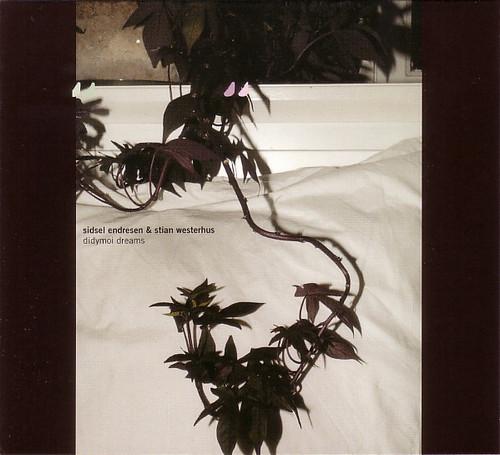 Sidsel Endresen and Stian Westerhus recorded Didymoi Dreams back in 2011 live at the Nattjazz Festival in Norway, but have not had an opportunity to release it as a record until now. Endresen's characteristically enigmatic caterwauling hits new peaks of oddity while Westerhus provides her a scarred drone landscape, making for one of the more unique releases of 2013 so far.
Sidsel Endresen and Stian Westerhus recorded Didymoi Dreams back in 2011 live at the Nattjazz Festival in Norway, but have not had an opportunity to release it as a record until now. Endresen's characteristically enigmatic caterwauling hits new peaks of oddity while Westerhus provides her a scarred drone landscape, making for one of the more unique releases of 2013 so far.
Endresen's nonsensical syllabic sentences are bound to turn some people off from this record. As I discovered in 2011 with the equally excellent Ha! featuring Humcrush, Endresen's voice is something to become conditioned to thoroughly before enjoying the music. Sidsel speaks in a clattering, layered spray of emotive bursts and word extracts, as if plucked from larger lyrics. As she continues along in each piece over the course of the album, she grows more adaptive to Westerhus' guitar manipulations, gradually transforming her voice from a percussive instrument to a smooth, horn-like imitation. His input is mostly atmospheric on this recording, where earlier collaborations with Sidsel were more foregrounded, but it does not go unappreciated. Gentle murmurs and bass give way to caustic distortion, accenting Sidsel when her voice grows softer or more staccato.
Strangely enough, Sidsel's voice is not far removed from the fringes of traditional jazz scat singing, but it gets closer to a terrified glossolalia than ever before on Didymoi Dreams, taking baby-talk phonetics and plosives and crushing them into compact strings that resemble sped up interviews in a foreign language. Meanwhile, Stian sees opportunities to match her remarkable physical control with synthesized digital elements, looping harmonics and string plucks in complement. I keep feeling the need to revisit "Barkis Is Willing," due to its uniqueness; an exercise in suspended animation that is impressively terrifying for its tense displacement of silence.
samples:
 
 
 
Read More
- Administrator
- Albums and Singles
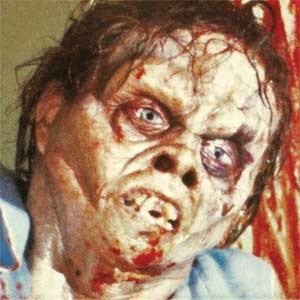 After 12 years and two very small cassette editions on American Tapes and Hanson Records, Dilloway and Drumm's I Drink Your Skin is available on CD. Dressed up in cheesy horror movie duds and packed tight with overblown noise, Aaron and Kevin each dish out a 25 minute ribbon of goofy loops, obnoxious high-end squeals, and blathering garbage sounds. It is gruff, but invigorating stuff—and more carefully put together than it at first appears.
After 12 years and two very small cassette editions on American Tapes and Hanson Records, Dilloway and Drumm's I Drink Your Skin is available on CD. Dressed up in cheesy horror movie duds and packed tight with overblown noise, Aaron and Kevin each dish out a 25 minute ribbon of goofy loops, obnoxious high-end squeals, and blathering garbage sounds. It is gruff, but invigorating stuff—and more carefully put together than it at first appears.
For I Drink Your Skin Dilloway and Drumm each made up a composition of sounds generated by the other guy. According to the Hanson website, the samples Aaron gave Kevin consisted of loops pulled from a Renaissance eight-track tape, and the mini-disc that Kevin sent Aaron was covered in spilled coffee—its contents a mystery. The way Dilloway treats them, it probably doesn't matter. His side of the release piles stroboscopic flashes of God-knows-what on top of rhythmic loops and interminable waves of full-spectrum clutter. It's hard to concentrate on any one part of Dilloway's track, but he glues the whole thing together with a series of identifiable loops, which are separated from each other by piercing high frequency tones shrill enough to piss off the neighbor's dog. I wouldn't call it a suite exactly, but I hear at least three distinct sections on this track. The sound is as turbulent and harsh as anything else Aaron's done, but those loops hold it all together and give some shape to the otherwise shapeless chaos of his work.
Drumm also uses a loop or two on his side, but he treats them differently by carving some space out around them. One of those loops sounds vaguely like a cut and spliced horn section from Renaissance's "Mother Russia," though I can't be sure of it. It also sounds like something from a Mystery Science Theatre 3000 episode: blithe enough to be fun, but working hard to sound scary too. Lots of flanging, oddball pitch-bending, and a pinch of Theremin-like spookiness further add to the funhouse effect. That kind of variety and relief makes it easier to focus on everything Kevin pushes through the speakers, and by working with concentrated aggregates of noise, he keeps the details from rushing by too quickly. The sounds are still harsh, they're just a touch more approachable thanks to the way Drumm handles them.
I'm glad Hanson finally made this album more widely available. Both pieces are intense, heavy, and just as much fun as anything found on either artist's better known albums. Remember, Sheer Hellish Miasma and Dread were both recorded around the same time as I Drink Your Skin, so it comes from a particularly strong period for both of them. That it is not as well known is only a matter of availability, not quality. Now that there are more than 100 cassette copies floating around, I suspect it will win a lot more love.
samples:
 
Read More
- Administrator
- Albums and Singles
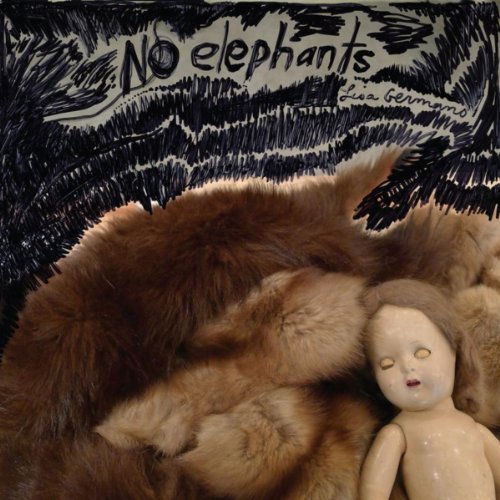 Germano walks a line between serene peace and dissonant chaos. She dips from one into the other on the piano while her voice remains unwavering; songs carry themselves with a cinematic air that feels compact, hanging on to every word and symbol with tenacity.
Germano walks a line between serene peace and dissonant chaos. She dips from one into the other on the piano while her voice remains unwavering; songs carry themselves with a cinematic air that feels compact, hanging on to every word and symbol with tenacity.
When Lisa gets happy, the environment behind her shifts into gentle strings and splendor; when she's contrite, the songs bend and warp under her guilt, where everything is wrong notes and missed beats. It's often so exactly choreographed that it seems she's conducting it by some precise magic in her voice. She commands each verse patiently; decades of time spent writing songs have rewarded her with an uncanny control over mood and she doesn't squander it.
No Elephants is a minor success in Lisa Germano's extensive catalog of music, carried by a unique sparseness of instrumentation, lucid songwriting, and the adroit, immerse production lent by Jamie Candiloro. She is at her best in uneasy tensions, dissecting minor key progressions into bizarre assemblages and serenely drifting away from the world. It doesn't carry the weight of prior successes, but that is kind of the point: weightlessness.
Candiloro, meanwhile, assists Germano on electronic drum loops, field recordings, and a lot of "cell phone," which is to say a plethora of ringing sounds and the buzzing that a phone makes through speakers before you receive a call. I have heard the latter utilized before in a few songs as a novelty, but songs like "No Elephants" and "Dance Of The Bees" are the first real attempts I've heard to introduce it like a genuine instrument. Oddly enough it works, especially when layered into Germano's mandolin or piano and bass from Sebastian Steinberg.
There are a couple of lesser tunes on No Elephants, some that seem to try and ape the ephemeral beauty of "Snow," however, I would not necessarily call them missteps. These songs contribute to the album's sense of light and space as much as the catchier compositions, gliding along like taking a sightseeing tour in a sleepy haze. These weaker songs might not be memorable but they faithfully maintain the album's atmosphere, to their credit. Only at the album's conclusion, the wistful "Strange Bird," do I really feel I've been planted back on the ground, and by that time it's been a pleasant and welcome reprieve from the outside world.
Her first album since 2009, No Elephants is a delayed follow-up to Magic Neighbor, a continuation of its mood and stripped-back style. Scarcer and more removed than ever before, it shows the deliberate evolution of a kind of quiet and delicacy that can't be faked. In focusing her efforts, Germano has brought her trademark earnestness to the odd new circumstance of losing all touch with the world.
samples
Read More
- Administrator
- Albums and Singles
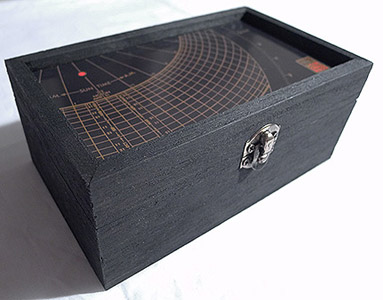 Aeronaut, who is Steve Fors (and half of the combo The Golden Sores) has been working at his sparse, complex approach to sound art for quite a few years now, but it all comes together beautifully on Coronal Mass, his first full physical release, presented beautifully in a hand-made box painted by the artist himself.
Aeronaut, who is Steve Fors (and half of the combo The Golden Sores) has been working at his sparse, complex approach to sound art for quite a few years now, but it all comes together beautifully on Coronal Mass, his first full physical release, presented beautifully in a hand-made box painted by the artist himself.
On each of the two 18 minute compositions, Fors allows himself to stretch out and fill every moment of those durations, but in a constantly shifting and evolving sort of way.The A side initially crackles with digital static offset by rising and falling melodic calls, blending melody with chaos.Soon all transitions to the blissful, soft tones, intertwined with one another.
While by no means descending into awful new age territory, there is a peaceful warmth throughout, and even once a bit of distorted electronic guitar enters the mix, the delicate balance is not upset.The guitar eventually envelops the entire piece in gauzy, yet sharp haze that embraces both dissonance and beauty.
The second piece stays even further away from the harsher passages, opting instead for a bleaker, more dour mix.Bowed tones and shifting passages of melody conjure up a distinct darkness that is moody, but not at all uncomfortable.Again, the more understated moments are buried in a passage of soaring, lush guitar squall before pushing the piece into a climax of glorious noise.
All too often works like this fall into rote repetition and time-filling genre clichés, but that never happens on Coronal Mass.Fors pieces together two long compositions that never become static, but always seem to be moving and flowing into one another, creating a fascinating microcosm of sound that stands out as unique, but is in league with the best works of sound art.
samples:
 
Read More
- Administrator
- Albums and Singles
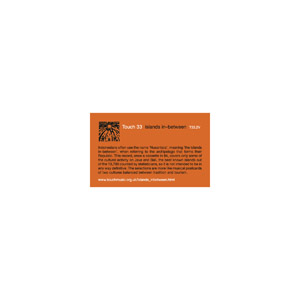 A wonderfully symbolic pairing of vinyl albums celebrating the timeless label's 30th anniversary last year. Islands In-Between reproduces the first non-compilation release, (a series of field recordings by label owner and curator Jon Wozencroft) and a double album celebration featuring contributions by much of the label's current roster. The pairing shows where the label has been and where it is going, and that consistency has not waned in these three decades.
A wonderfully symbolic pairing of vinyl albums celebrating the timeless label's 30th anniversary last year. Islands In-Between reproduces the first non-compilation release, (a series of field recordings by label owner and curator Jon Wozencroft) and a double album celebration featuring contributions by much of the label's current roster. The pairing shows where the label has been and where it is going, and that consistency has not waned in these three decades.
Islands In-Between was the first full-length work published by the label as a cassette in 1983, capturing music and local ambience found throughout Wozencroft's travels in Java and Bali.While apparently consisting of 15 distinct pieces, it works best as two side-long experiences that natural sit alongside each other.
As far as the music presented goes, gamelan is heavily represented throughout, from the complex, polyrhythmic "Gending Gending" and two separate "Degugn Instrumental" pieces, all of which make for dense, hypnotic works that occasionally drop to a slow, pensive pace before once again returning to the unrelenting rhythms."Cremation Gamelan" and "Ramayana II" are barer, conveying a more reverent, ceremonial tone within them.
Interspersed throughout these pieces are a variety of field recordings taken in the area."Watermark" is perhaps the perfect synopsis of the label, albeit one taken 30 years ago:a subtle suite of insects and frogs convey a timeless, organic sensibility before being rudely interrupted by the aggressive, modernist sound of a revving motorcycle engine."Frog Sound" and "Ducks", while giving away their sources in their respective titles, appearmuch more complex when detached from their natural habitat.At times the croaks and bird calls sounds seem to drift into what more closely resembles traditional instrumentation rather than natural phenomena.
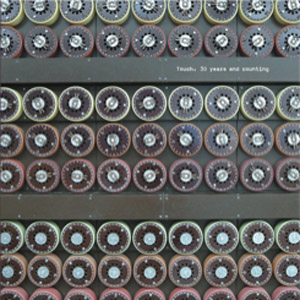 Fast forward 30 years, and the double album celebration of the label, consisting of 18 exclusive pieces from most of the label’s active roster, feels more like a cohesive composition rather than a compilation.With the vinyl showing no clear delineation between pieces, and the CD version indexed as four songs, it is surely no accident.
Fast forward 30 years, and the double album celebration of the label, consisting of 18 exclusive pieces from most of the label’s active roster, feels more like a cohesive composition rather than a compilation.With the vinyl showing no clear delineation between pieces, and the CD version indexed as four songs, it is surely no accident.
Other than the first piece, a field recording by Wozencroft as Touch 33, the remainder of the first side is the only point where who exactly is being heard can be questionable.Fennesz's "55 Cancri e" retains his understated sense of melody, but buried amidst a low frequency layer that segues almost too well into Bruce Gilbert's sweeping electronic and metallic groans on "Apis."This too is a bit difficult to discern where it ends and Rosy Parlane's "Awhitu" begins.It is only through the occasional obvious guitar scrape that Oren Ambarchi's "Merely a Portmanteau" is obvious.
The remaining three sides pair more contrasting artists and pieces together, from the sparse piano tones and low end swells of Eleh's "Overwoven" into BJNilsen's London field recording "The cackle of dogs and laughter of death" and the sequenced white noise of Nana April Jun's "High and Low and Mid Plane Mass".Ironically, these pairings can also seem to favor one artist over another:CM von Hausswolff's "Cleansing of the Cruel Tyrant's Chamber" buries a rhythmic pulse under a brittle layer of noise, while Jana Winderen creates a similar ambience with "In a Silent Place" via submerged hydrophones, but knowing the organic nature of her work, as well as the other elements of the environment captured makes her contribution more compelling.
Taken independently, Mika Vainio's "Erstwhile" is quite strong, with sounds generated via electric guitar destroyed and reconstructed digitally to bear almost no resemblance to where they began.Biosphere's "Gryfici" somehow manages to capture the sounds of his bike's brakes and reshapes them into an appropriately grinding, but also melodically understated composition.
The contrast of how these two albums are presented does a great job of demonstrating how the label has evolved as well:Islands In-Between is a plain white sleeve, with an unlabeled vinyl inside, only discerned by a small sticker adhered to the front.Conversely, Touch 30 is a lavish gatefold LP, beautifully capturing Wozencroft's photography and understated sense of design.As a label, Touch has consistently impressed me ever since I heard my first work from them, which I believe was New Order's Video 586 (which remains a favorite).As I have been following them since, there are always works I favor more than others, and these milestone releases continue that tradition.
samples:
- Gending Gending
- Ramayana II
- Watermark
- Overwoven (Eleh)
- In A Silent Place (Jana Winderen)
- Gryfici (Biosphere)
 
Read More
- Administrator
- Albums and Singles
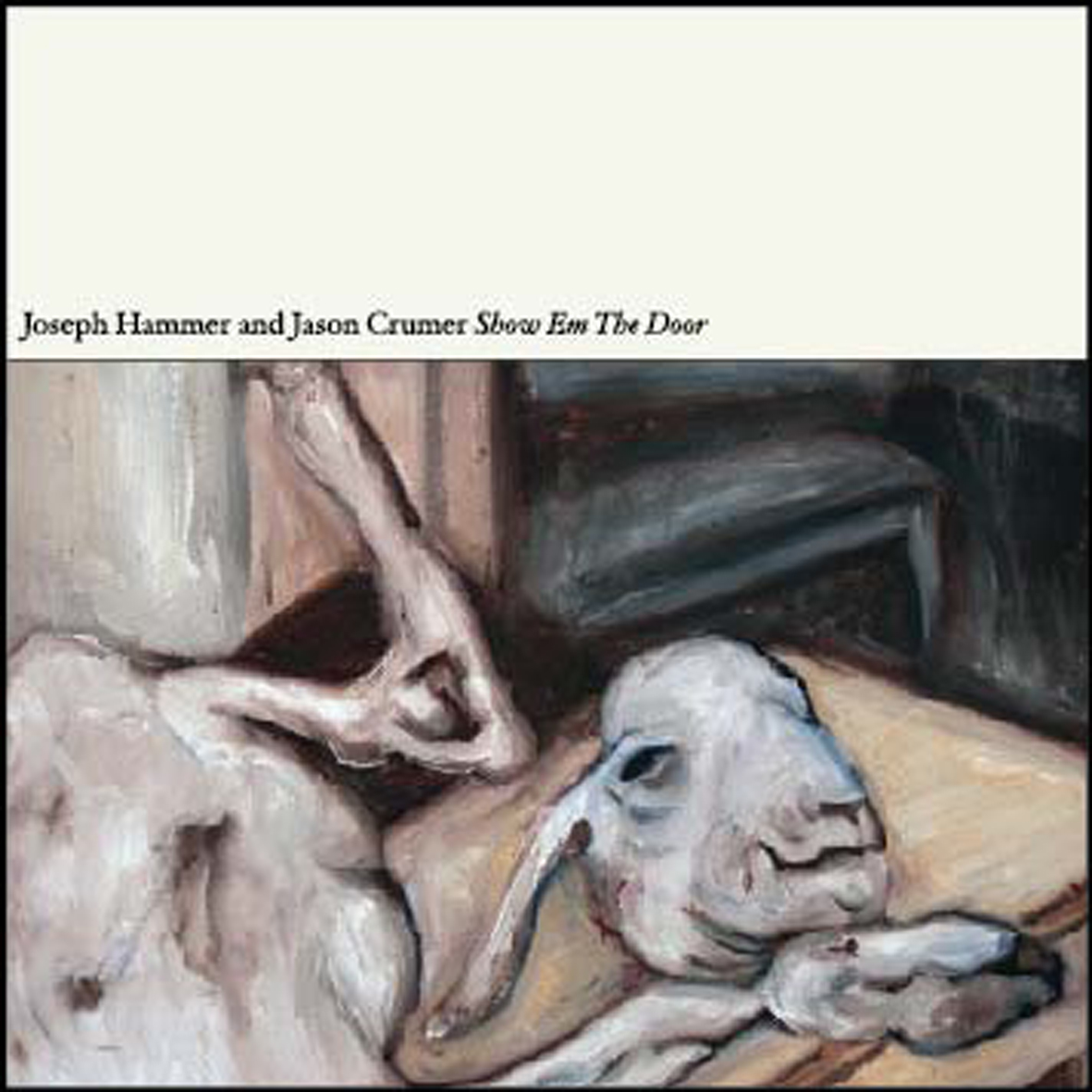 This collaboration between veteran LAFMS tape loop wizard Joseph Hammer and harsh noise titan Jason Crumer is not something I ever expected to happen, so the appearance of this album was an incredibly pleasant surprise.  Even better, the album feels like a true collaboration: while some of Hammer's distinctiveness is necessarily eclipsed by Crumer's flame-throwing, the contrast between the two artists' styles ultimately heightens the impact of both the more musical passages and the searing noise eruptions.
This collaboration between veteran LAFMS tape loop wizard Joseph Hammer and harsh noise titan Jason Crumer is not something I ever expected to happen, so the appearance of this album was an incredibly pleasant surprise.  Even better, the album feels like a true collaboration: while some of Hammer's distinctiveness is necessarily eclipsed by Crumer's flame-throwing, the contrast between the two artists' styles ultimately heightens the impact of both the more musical passages and the searing noise eruptions.
Sadly, it took me entirely too long to become familiar with Hammer's work, as the LA Free Music Society is decidedly not my scene at all and his solo work is quite hard to come by (though he did release an album on Pan in 2010 that somehow eluded me).  While he does not sound much like Jason Lescalleet, the two have a lot in common, as they both work with tape loops and have been quietly making great, unique music for a very long time and seem completely immune to the comings and goings of various trends and scenes.  Hammer's methods are quite a mystery to me, but he generally seems to create slowly building collages from blank tape loops and snatches of radio transmissions.
Crumer, for his part, is similarly unfazed by shifting trends, as nearly all of his former North American harsh noise peers have moved onto either drone music or something beat-oriented, yet he is still doing the same thing that he has always done and is absolutely killing at it.  The sheer violence of Crumer's work makes this quite an interesting and challenging collaboration, as it necessitates a lot of restraint and space on his part to allow Hammer's quieter, more slow-moving contributions to fully flower.  In fact, there are some pieces in which I wish Jason had been a lot more aggressive, such as the closing "TB Blues" (the album's sole misstep).  Hammer has plenty of time to unfold and develop that piece's looped accordion motif, but it is not particularly interesting and Crumer never gets around to exploding, opting instead to just sputter and simmer in the background.  Also, the periodic coughing and wheezing is fairly annoying and unfunny (I suppose it was rather naïve of me to expect no LAFMS-style wackiness at all on this album).
The remaining three pieces, however, are generally quite spectacular and tend to highlight both musician's strengths.  The title piece, for example, gradually evolves from a slow burning throb into a lurching, crunching, and oft-explosive Crumer apocalypse before giving way to a sputtering and stuttering outro of looped acoustic guitars and radio noise.  "Guitar," unsurprisingly, also features acoustic guitars quite prominently.  It takes time to get going, as it sounds like a tape recorder falling down a very long flight of stairs for much of its duration, but it gradually coheres into something quite melancholy and melodic by the end. The remaining piece, "Banner Drop," is probably the most perfect blurring of the two styles, as a grinding and dissonant electric guitar loop is violently slashed and battered by Crumer's eruptions of noise before gradually subsiding into a soothing industrial hum.
In general, I prefer the moments when Crumer allows himself to fully open up with ear-shredding blasts, but that is mostly because he allows himself to do it so infrequently.  Consequently, it tends to hit quite hard when it happens.  He and Hammer probably made as fine an album as could be expected, given the small amount of time they have had to work together and the sizable gulf between their styles.  Show Em The Door is not perfect, but Jason and Joseph definitely sound amazing on the occasions when they manage to lock together perfectly.  Also, I am surprised that this union even worked at all, as it seemed to me like Hammer's work needed a great deal of time and space to fully cohere...and it does, but I failed to anticipate how great it could sound if his work sneakily cohered behind the scenes as I was being blasted by cascading white noise and metallic crunches.
 
Read More
- John Kealy
- Albums and Singles
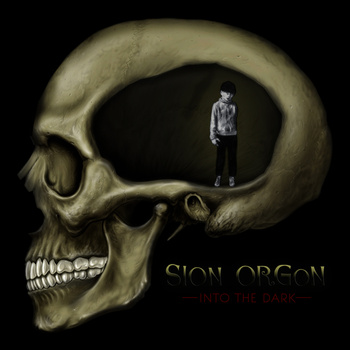 This short communication from Sion Orgon consists of a pair of very sweet tracks. Both feature Peter Christopherson but those looking for something that sounds like one of Sleazy’s projects will be left wanting as Orgon has made two great little pieces in his own image. Straddling weird lunar soundscapes and the less jittery side of prog rock, this single is brief, beautiful, and hopefully a portent of more to come.
This short communication from Sion Orgon consists of a pair of very sweet tracks. Both feature Peter Christopherson but those looking for something that sounds like one of Sleazy’s projects will be left wanting as Orgon has made two great little pieces in his own image. Straddling weird lunar soundscapes and the less jittery side of prog rock, this single is brief, beautiful, and hopefully a portent of more to come.
 
"Into the Dark" features, alongside Orgon and Christopherson (who contributed "manipulations and field recordings"), Thighpaulsandra and Seb Goldfinch, who bring shedloads of synthesisers and violin respectively.There is something off about the first half of the song (in a very good way). Orgon develops the piece with the sort of pacing that would leave a good horror director green with envy before the song bursts into a gorgeous vocal performance by Orgon; commanding yet human, it brings to mind some other Davids such as Bowie and Sylvian and it is absolutely mesmerizing.
On "Paper State" it is just Orgon and Christopherson’s field recordings (which are hard to discern). There is a melancholic edge to the music, a sadness that is just beyond memory but still leaves a phantom pain. In its few minutes of playing time, "Into the Dark" covers a remarkable scope without ever feeling like it has gone anywhere; its unassuming complexity is most impressive. Usually I find myself returning to 7" singles rarely as I am lazy and they require much more attention than an LP but between these two songs, I am drawn towards this little black disc more often than I would have anticipated.
 
Read More
- John Kealy
- Albums and Singles
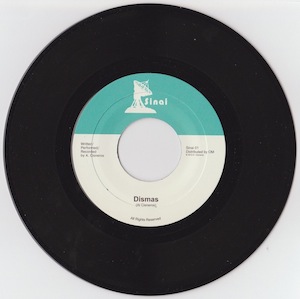 Al Cisneros, better known as the bassist and vocalist in Sleep and Om, has released a single reflecting his current obsession with dub. As it is self-released on his own new label, Sinai Records, this hopefully marks the beginning of another outlet for Cisneros on top of his already impressive CV. Even if it is only a one-off, “Dismas” is an unexpected and fascinating aside from Cisneros that complements his main work remarkably well.
Al Cisneros, better known as the bassist and vocalist in Sleep and Om, has released a single reflecting his current obsession with dub. As it is self-released on his own new label, Sinai Records, this hopefully marks the beginning of another outlet for Cisneros on top of his already impressive CV. Even if it is only a one-off, “Dismas” is an unexpected and fascinating aside from Cisneros that complements his main work remarkably well.
Sinai
While this is no exercise in genre hopping, "Dismas" certainly wears its influence on its sleeves mixing religious themes (the title of the song refers to the penitent thief crucified beside Christ at Golgotha) with a mix of Cisneros’s Raga, reggae and Middle Eastern bass playing style. With only a little rearrangement, this song would fit perfectly with Om’s current direction though in place of his own vocals he uses samples of a religious sermon or preacher.
Yet, the final result is something that sounds a little like the work his band mate Emil Amos, particularly his sample-heavy project Lilacs & Champagne. "Dismas" flows and does not outstay its welcome as if it was stretched out to a normal Om length, it would grow quite tiresome. Indeed, I would have preferred a different B-side as the second version of "Dismas" does not stray too far from the first version despite being slower and more sluggish.
 
Read More
- Administrator
- Albums and Singles
 The follow up to last year’s EP Infernal Memo, Mat Sweet’s is first full length away from Kranky melds John Milton’s Paradise Lost with further developments in his writing and performing style. Moving further into musically (almost) upbeat territory while keeping the lyrics suitably bleak, Burnt Up On Re-Entry is another terrific addition to Sweet’s repertoire.
The follow up to last year’s EP Infernal Memo, Mat Sweet’s is first full length away from Kranky melds John Milton’s Paradise Lost with further developments in his writing and performing style. Moving further into musically (almost) upbeat territory while keeping the lyrics suitably bleak, Burnt Up On Re-Entry is another terrific addition to Sweet’s repertoire.
It might sound odd but the opening track, "Fiery the Angels Fell," is as indebted to mainstream "alternative" acts as it is to Sweet’s older nocturnal explorations. Drum machines, synths and chunky guitars create a constantly shifting background for the apocalyptic words which are sang with more clarity than on previous releases. This approach is a surprise but it works. The style is the template for the rest of Burnt Up On Re-Entry and overall this sounds like the great dark pop album of the '90s that was never made.
Yet just when I feel I know where the album is going, "Drexelius Sick Man Quarles Embemes Closed Heaven" shifts course altogether. Heavily processed vocals and Warp Records circa 1995 beats and soundscapes take me entirely off guard. It sounds brilliant both on its own and within the greater context of the album as it is a microcosm of some of the techniques used on other songs, forming a coherent but unexpected interlude during Burnt Up On Re-Entry.
While the overall style might be changing with every Boduf Songs album, what remains constant is the quality of Sweet’s lyrics and the heavy mood that covers the music like a shroud, no matter how accessible or tongue-in-cheek it might be.On the aforementioned "Fiery the Angels Fell," for example, Sweet mixes the lyrics to "It's Raining Men" with the ghastly imagery of people leaping from tall buildings to a wet, pulpy end. On the sublimely titled "Whither Thou Goest, Cretin," Sweet creates a basic, repetitive motif of a beat and bass line that should not sound so creepy for something that is so simple but it inexplicably sparks a panic. So many industrial, noise, or metal bands try to reach the same levels of bleakness and fail to come close to Sweet’s intonation of the mantra "Everyone Will Let You Down in the End" over a beautiful pair of guitar melodies. The song is already devastating before Sweet unleashes a huge sounding Sabbath-like riff to tip the whole thing over the edge.
Compared to albums like This Alone Above Else in Spite of Everything and How Shadows Chase the Balance, Burnt Up On Re-Entry does not quite reach the same despairing depths but it demonstrates that Sweet is unwilling to tread the same boards over and over again. Moreover, I feel that as well as being a good follow up to those frankly wonderful albums, this one has the capacity to find a larger audience for Boduf Songs. Whether that is a good or bad thing depends on a lot of factors. On one hand, I would love to see them live again but on the other, the fact that there is an almost cultish secrecy to Sweet’s music means that any dilution could destroy it.
samples:
- A Brilliant Shaft of Light from out of the Night Sky
- Whither Thou Goest, Cretin
- Everyone Will Let You Down in the End
 
Read More
- Administrator
- Albums and Singles
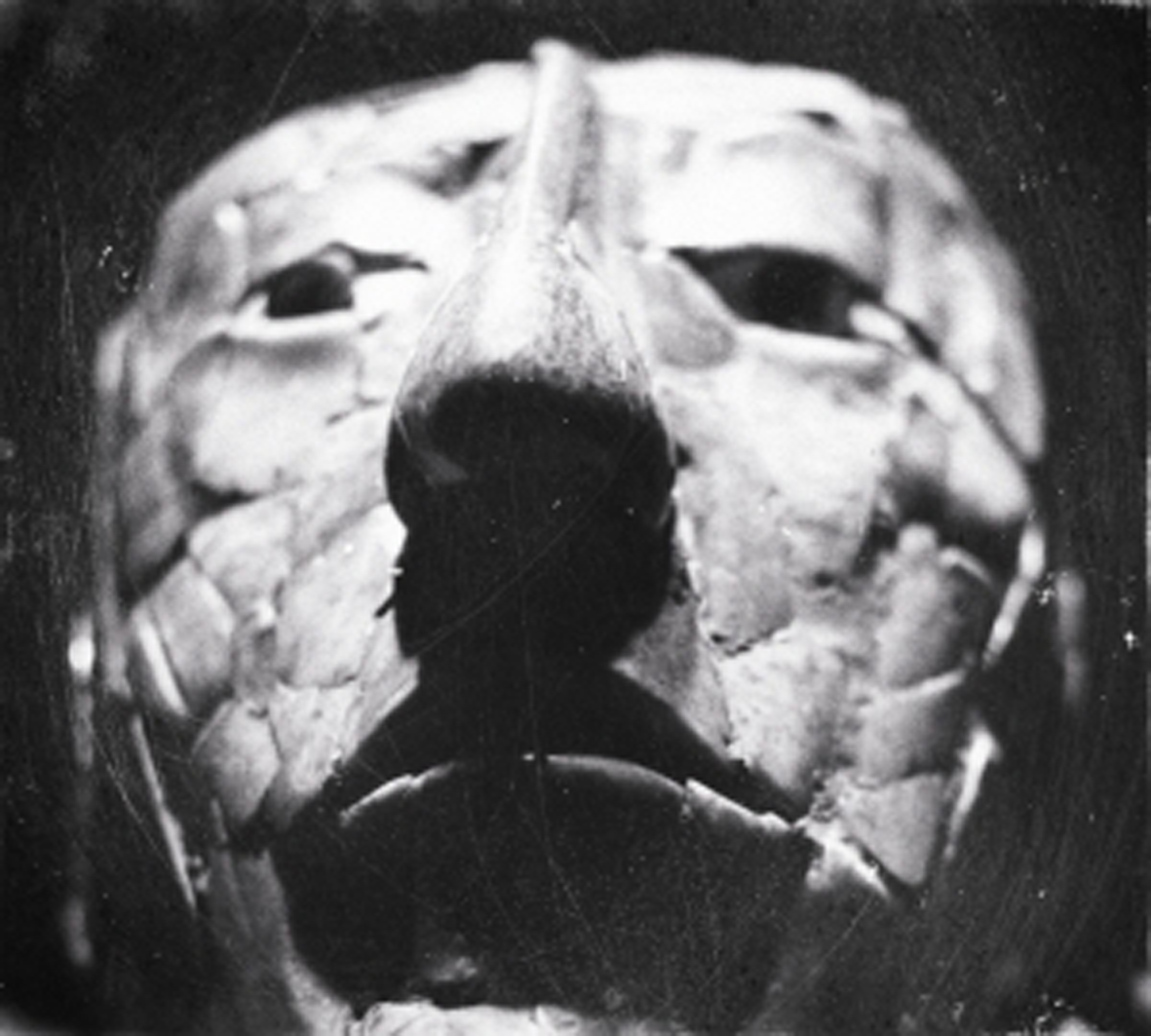 After a decade-long hiatus, Aki Onda returns to his field recording series with a collage of recordings made during his first trip to Mexico back in 2005.  While the recordings themselves form a evocative and sometimes beautiful narrative, the surreality of Aki's travelogue is further enhanced by the fact that two of his three recorders began malfunctioning during the project.  As a result, South of the Border is occasionally bizarre enough to transcend the field recording genre and drift into relatively uncharted and unpredictable territory.
After a decade-long hiatus, Aki Onda returns to his field recording series with a collage of recordings made during his first trip to Mexico back in 2005.  While the recordings themselves form a evocative and sometimes beautiful narrative, the surreality of Aki's travelogue is further enhanced by the fact that two of his three recorders began malfunctioning during the project.  As a result, South of the Border is occasionally bizarre enough to transcend the field recording genre and drift into relatively uncharted and unpredictable territory.
South of the Border endearingly begins in what is quite possibly the least hip and experimental way possible, as "A Day of Pilgrimage" is essentially nothing more than a recording of a vaguely sad and out-of-tune-sounding marching band followed by a minute or so of muted, subtly distorted street noise.  Such an odd opening to the album definitely wrong-footed me, as it seems like there is nothing at all particularly artful about the piece: it is literally just a fairly lo-fi recording of a parade and nothing more.  Still, it had enough of ramshackle charm and mystery to it to make me want to keep listening, which turned out to be a good decision.
My gratification was not exactly instant, however, as the 9-minute piece that follows (the prosaically titled "Dust") seems to be just a largely untreated recording of a dust storm.  Fortunately, a few hints of something more begin to appear, as odd mechanical noises and an brief tape-distressed voice intrude upon the desolate-sounding low roar of the wind.  Thankfully, this quizzical effort finally blossoms about a third of the way through "Bruise and Bite," as the seemingly directionless hiss and crackle that opens the piece suddenly gives way to a very clear and haunting flute melody of some kind.
The transition caught me completely off-guard, as South of the Border immediately went from sounding like something harvested from Chris Watson's studio trash to something that sounds like a beatless Muslimgauze.  From that point onward, it became clear to me that while Aki's mental process may be entirely baffling to me, he is actually in complete control of what he is doing.  As the forlorn flute is joined by blurred and indecipherable human voices and a tortured-sounding counter-melody, "Bruise and Bite" evolves into something truly beautiful and moving.  Of course, it would have been nice if Onda's triumph was not bloated by its seemingly pointless four-minute introduction, but I suppose all of that unpromising hiss and clatter was necessary for the big surprise.
Happily, Onda's hot streak continues off and on for the rest of the album.  The unpromising marching band tenaciousnessly returns for "The Sun Clings to the Earth and There is No Darkness," but they are gradually drowned out by a rather distressed recording of a flock of birds that sounds sounds increasingly menacing and apocalyptic.  Then the album's lengthy final piece, "I Tell A Story of Bodies That Change," successfully reprises the droning-and-melancholy-flutes aesthetic of "Bruise and Bite."  It never comes anywhere near reproducing the aching beauty of its predecessor, but Aki gets significantly more ambitious with his collaging, so its 17 minutes follow a compelling unpredictable and subtly shifting trajectory.
Uncharacteristically, I have listened to this album several times without ever quite figuring out quite what Onda is trying to do or whether or not he may have succeeded.  I do know that Mexico is a very significant place for Aki, which stems from both a love of Alejandro Jodorowsky's El Topo and Aki's own childhood memories of his Olympian father's videos taken during the '68 Summer Olympics.  Consequently, I suspect that there is a lot of hidden meaning and emotion in these recordings that does not quite translate to me.  Still, my jaded ears were definitely struck by both "Bruise and Bite" and the subsequent bird attack. Otherwise, South of the Border remains something of an enigma for me, lying somewhere between "15 great minutes embedded in a sea of relative non-inspiration" and "a mysterious aesthetic too personal and unique for me to fully grasp."  Odds are, it is the former, but it is certainly an unusual and curiously ambiguous effort regardless.
- Bruise and Bite
- The Sun Clings To The Earth And There Is No Darkness
- I Tell A Story Of Bodies That Change
 
 
Read More

